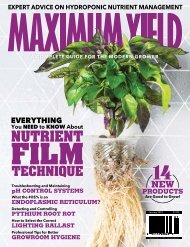Maximum Yield Canada July/August 2017
While hydroponics is unlikely to overtake traditional agriculture economically anytime soon—current US annual crop production is estimated at $143 billion while hydroponics is valued at a mere $600 million—it’s not so much as how much is being grown but where. Today, nobody knows what society will be like in 2100. We hope it will be a peaceful, healthy, and happy place.
While hydroponics is unlikely to overtake traditional agriculture economically anytime soon—current US annual crop production is estimated at $143 billion while hydroponics is valued at a mere $600 million—it’s not so much as how much is being grown but where. Today, nobody knows what society will be like in 2100. We hope it will be a peaceful, healthy, and happy place.
Create successful ePaper yourself
Turn your PDF publications into a flip-book with our unique Google optimized e-Paper software.
plant analysis<br />
The plant analysis lab report generated usually states<br />
each of the macroelements (N, P, K, Ca, Mg, and S) as a<br />
percentage of dry matter, while microelements (Fe, Mn,<br />
B, Zn, and Cu), present in much lower concentrations, are<br />
expressed as either parts per million (ppm), milligrams per<br />
kilogram (mg/k), or micrograms per gram (μg/g). Some lab<br />
reports will also include a guide to the ideal foliar level<br />
range of each nutrient for specific crops to compare the<br />
results against, but not all do. Instead, guidelines for the<br />
most commonly grown hydroponic plants can be found<br />
in plant nutrition books and websites that indicate ideal<br />
levels for different species at different stages of growth. A<br />
list of foliar mineral levels at which deficiency or toxicity<br />
symptoms would be expected to occur are also useful to<br />
have on-hand when comparing plant analysis reports.<br />
“BY COMPARING<br />
the foliar mineral levels<br />
returned on a recent lab<br />
analysis to the healthy<br />
range for the plant<br />
species being grown, it’s<br />
possible to see which<br />
nutrients fall outside the<br />
recommended range.”<br />
Top: Many disorders and diseases can have symptoms similar to mineral<br />
deficiency/toxicities. Bottom: Foliar mineral analysis doesn’t take into<br />
account nutrients incorporated into other parts of the plant, such as fruit.<br />
When to Use Foliar Analysis<br />
Plant analysis can be used for different purposes. It has a<br />
vital role in crop research, where nutritional programs for<br />
new crops may be determined by analyzing the mineral<br />
content of well-grown, healthy plants. This data can then<br />
be used to formulate nutrient solutions or soil programs<br />
specifically aimed at maximizing plant nutrition for that<br />
crop. For those running small trials, foliar mineral analysis<br />
may be used to determine how different treatments,<br />
supplements, products, growing environments, and<br />
formulations affect the nutritional content of the plant.<br />
For growers, the most common use of foliar analysis is for<br />
when suspected deficiency or toxicity symptoms are starting<br />
to show on plants. Since many physiological, disease, and<br />
nutritional disorders can look quite similar, plant analysis is<br />
often used to rule out or confirm specific nutrient issues so that<br />
these can be rectified quickly and correctly.<br />
Foliar analysis is often used alongside nutrient solution<br />
analysis to determine necessary changes or supplements<br />
to prevent deficiencies from continuing to occur. It is also<br />
commonly used to confirm that nutrition has been optimal<br />
and that the nutrient formulation is suitable for the current<br />
stage of growth. Growers experiencing unexplained<br />
symptoms such as an overall lack of plant vigour, plant<br />
stunting, or low yields may use plant analysis to rule out<br />
nutrition as the specific cause of any issues, or to diagnose<br />
nutritional problems before they become more severe.<br />
Interpretation of Plant Analysis Lab Reports<br />
Recommendations for the ideal level of each nutrient in<br />
foliar samples vary slightly, depending on the reference<br />
source. For this reason, ideal levels are simply given<br />
as a range within which most healthy plants should<br />
fall. Typically, this is somewhat species dependant. For<br />
example, normal foliar levels of nitrogen in crisp head<br />
lettuce are often stated as being three to 4.5 per cent, while<br />
in tomato, a crop requiring a higher level of nutrition, are<br />
4.5-5.5 per cent; deficient levels would be less than two per<br />
cent. For potassium, ideal foliar levels are 4.5 to eight per<br />
cent in crisp head lettuce and four to six per cent in tomato,<br />
with deficient levels being below two per cent.<br />
Micro or trace elements often have a broader range of normal<br />
levels in healthy plants. In tomato, iron levels should be<br />
within the range of 80-200 ppm and manganese should be<br />
between 50-300 ppm, with iron levels becoming deficient at<br />
below 60 ppm and manganese below 20 ppm.<br />
By comparing the foliar mineral levels returned on a recent<br />
lab analysis to the healthy range for the plant species being<br />
grown, it’s possible to see which nutrients fall outside the<br />
recommended range. This can help pick up any potential<br />
issues before a stage of deficiency has been reached and<br />
plant growth becomes affected.<br />
36 feature

















